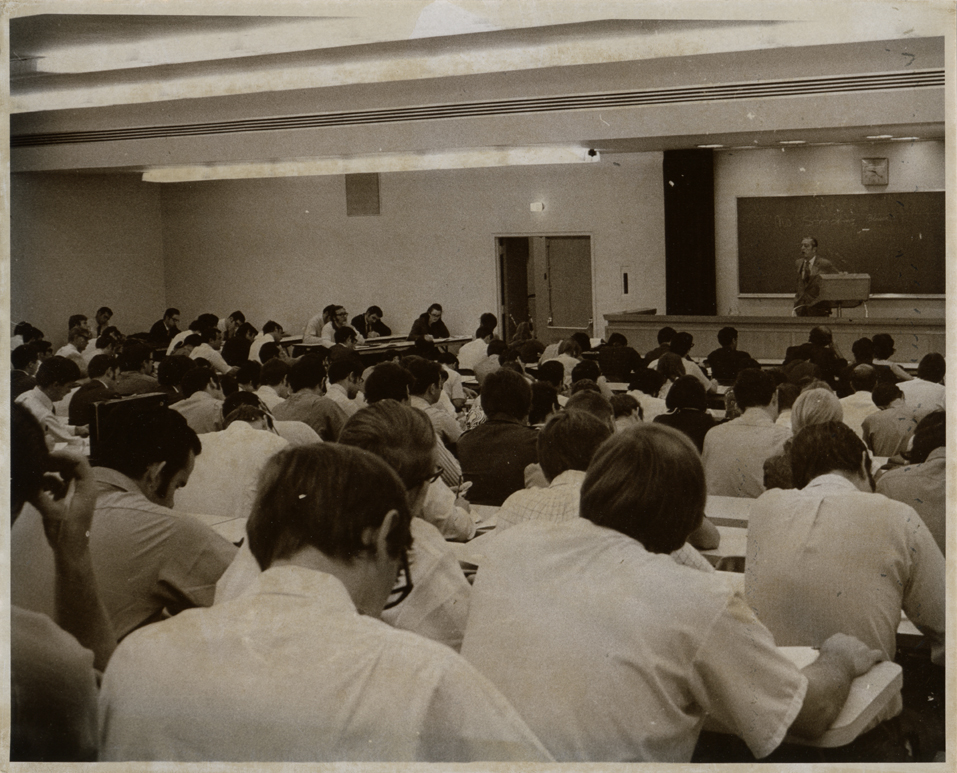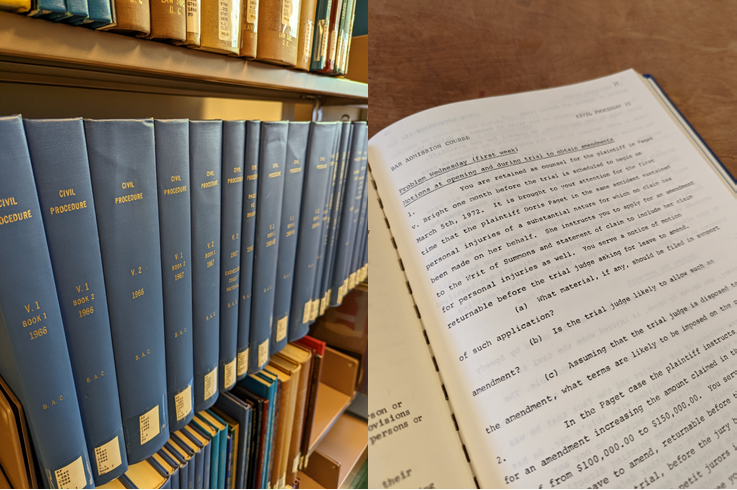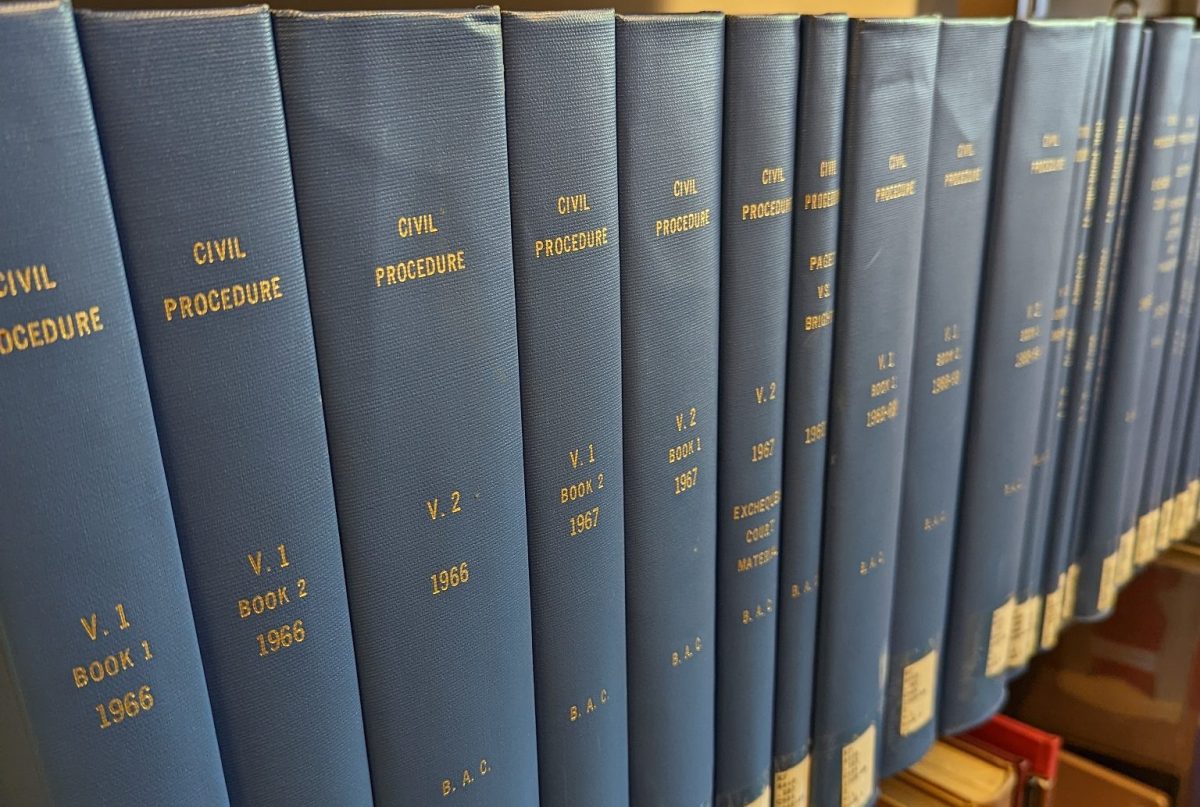The LSUC Bar Admissions Course materials were discontinued after 2005, but the Great Library collection includes some historical materials. In this post, we cover the history and status of these materials, and suggest some alternatives for your research.
What were the Bar Admission Course materials?
The Law Society of Upper Canada established its Bar Admission Course in 1959 after major changes to its legal education and training requirements [1]. Until the early 2000s, the Bar Admission Course was administered to licensing candidates as a largely mandatory seminar program after the completion of university law school education. Candidates’ knowledge was tested through a series of written examinations [2] [3]. The course comprised of in-classroom training addressing substantive and procedural law topics, as well as skills training; the accompanying reference materials are the “Bar Admission Course materials”.

(Lecturer is believed to be Donald Lamont). Image credit: Archives of the Law Society of Ontario, 997043-01P.

Early course materials were issued as cerlox-bound, typewritten legal-sized sheets. For ease of shelving and preservation reasons, the copies in the Great Library were bound in hardcover.

Early topics included: creditors’ rights and bankruptcy, corporation law, commercial law, domestic relations, Surrogate Court practice, bookkeeping, landlord and tenant law, legal aid, and limitation periods. [4] These older materials are stored in the Great Library’s staff-only basement area.
Prior to its discontinuation, the Bar Admission Course “produced 8, 4-inch binders of materials, one 4-inch binder for each subject” [5]. The 2005 course materials were organized into eight subjects: business law, criminal law, real estate, professional responsibility and practice management, estate planning and administration, civil litigation, public law, and family law. Copies of these newer materials were bound in hardcover and are found on the first floor of the Great Library’s print collection.

Where can I find historical bar exam materials?
Although recent study materials are no longer circulated, the Great Library carries some historical Bar Admissions Course materials from 1961 to 2005 (the last year of published Bar Admissions Course materials). Please note that there is more fulsome coverage of these materials after 1966. View the list of Bar Admissions Course materials in the LSO Great Library catalogue.
In April 2001, the Task Force on the Continuum of Legal Education was struck to study the period between law school and the call to the bar (i.e., the licensing process) [6] [7]. As part of its 2003 report to Convocation, the Task Force recommended that the Law Society continue to provide Reference Materials to licensing candidates but also to discontinue teaching substantive law to candidates in a classroom format [8]. They also recommended reducing the number of exams from eight to two [9].
By 2006, the Law Society eliminated the traditional Bar Admissions Course; in addition, written examinations were redeveloped as the barrister and solicitor exams [10]. As a result, the Bar Admissions Course reference materials were discontinued.
Where can I find more recent bar exam materials?
Except to current licensing candidates, the Law Society of Ontario no longer makes Bar Exam study materials widely available. These study materials are revised every year, protected by copyright, and “candidates are always strictly prohibited from disclosing to any person or organization, reproducing… or publishing any part of the Examination and study materials” [11].
Due to their restricted nature, the Great Library does not carry recent study materials in our collection.
What can I use for my research instead?
Legal researchers (who are NOT preparing for their licensing examination) may have referred to older bar admissions course materials as starting points for their research since the substantive information was organized topically. Since these materials are no longer widely circulated, here are other strategies to obtain substantive information by topic:
- Browse our free AccessCLE online database to locate continuing professional development materials that accompany the LSO’s CPD programming.
- Consult the Great Library’s Practice Collection. We carry current Canadian legal texts, which range from concise primers to lengthy, detailed treatises. Search our library catalogue or browse the texts located on our 2nd floor.
- Consult legal encyclopedias or restatements of the law such as the Canadian Encyclopedic Digest (via Westlaw) and Halsbury’s Laws of Canada (via Quicklaw).
References
[1] Malcolm Mercer, The Never-Ending Debate: What Should Be Required in Order to Become a Lawyer? (7 May 2018), online: Slaw.
[2] Ibid.
[3] Memorandum from Diana Miles, Director Professional Development & Competence to Professional Development and Student Directors, Law Firms; Career Development Officers, Law Schools; NCA Candidates (30 November 2005) Re: CanBarPrep, Law Society of Upper Canada, at 3, online (pdf): Wayback Machine.
[4] The subject breakdown of course material evolved over time. Those changes are reflected in our Great Library catalogue. Earlier topics included creditors’ rights, mechanics liens and bankruptcy; corporation law; commercial law (later, “business law”); domestic relations (later, “family law”); Surrogate Court practice; bookkeeping (later, “Accounting and analysis of financial statements”); real estate; estate planning (later, “Administration of estates”); civil procedure I & II; criminal procedure; landlord and tenant law; legal aid; professional conduct; and limitation periods.
[5] Supra, note 3.
[6] Ontario, Law Society of Upper Canada, Finance and Audit Committee, Professional Development and Competence Committee, Multi-Disciplinary Practice Task Force & Equity and Aboriginal Issues Committee, Transcript of Debates: April 26, 2001 (Toronto: Law Society of Upper Canada, 26 April 2001) at 14-15. Browse the Minutes of Convocation in the LSUC Digital Collection.
[7] Ontario, Law Society of Upper Canada, Task Force on the Continuum of Legal Education, Report to Convocation (Toronto: Law Society of Upper Canada, 23 October 2003) at para 1, online (pdf): Wayback Machine.
[8] Ibid at paras 46-48.
[9] Ibid at paras 69-70.
[10] See Appendix 1: Licensing Process For Admission To The Bar In Ontario at 5-10 in Ontario, Law Society of Upper Canada, Professional Development, Competence and Admissions Committee, Report to Convocation (Toronto: Law Society of Upper Canada, 24 February 2005), online (pdf): Wayback Machine.
[11] Law Society of Ontario, Licensing Examination Study Materials, online: Law Society of Ontario.
Discover more from Know How, the blog of the Great Library
Subscribe to get the latest posts to your email.


